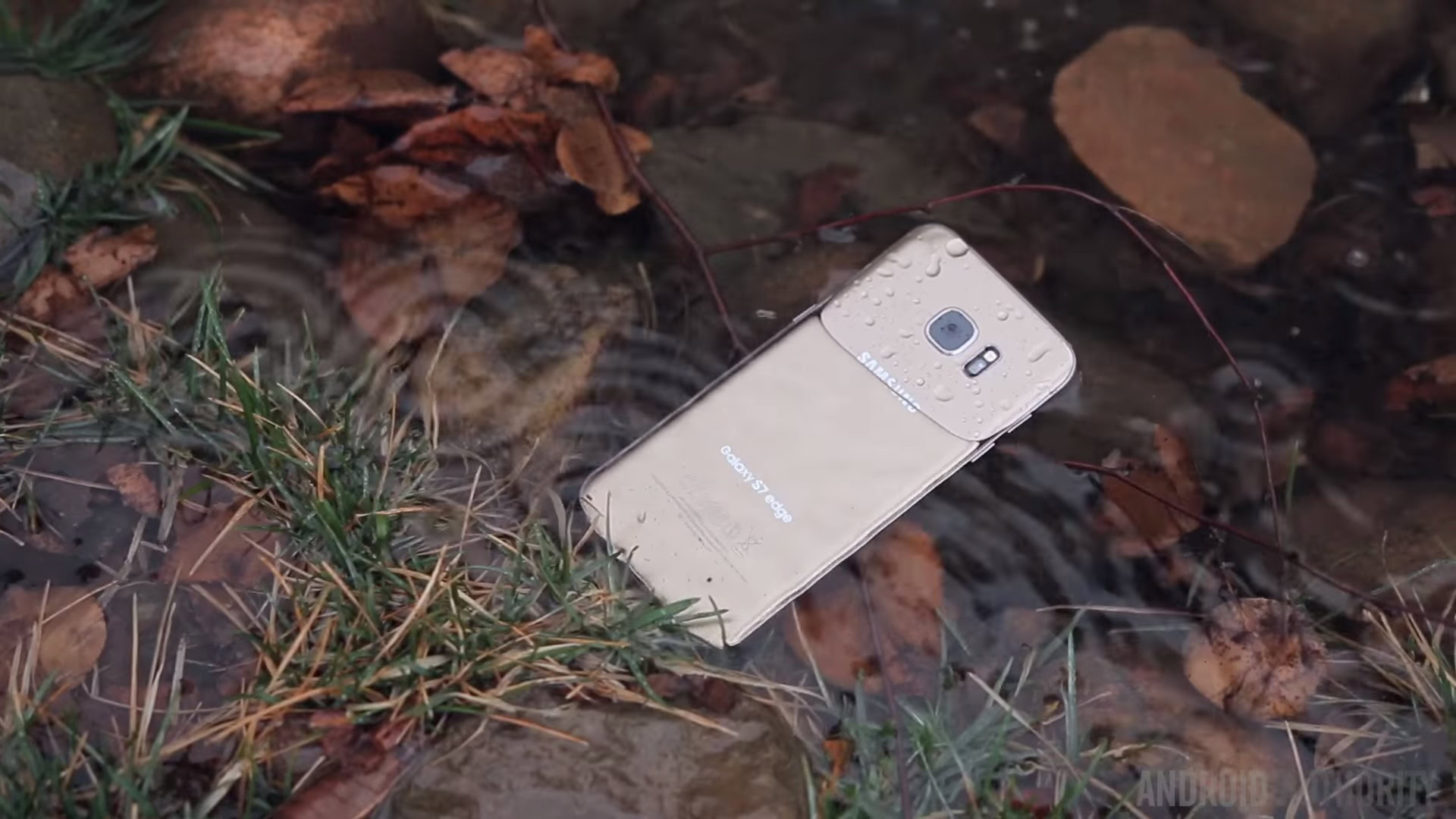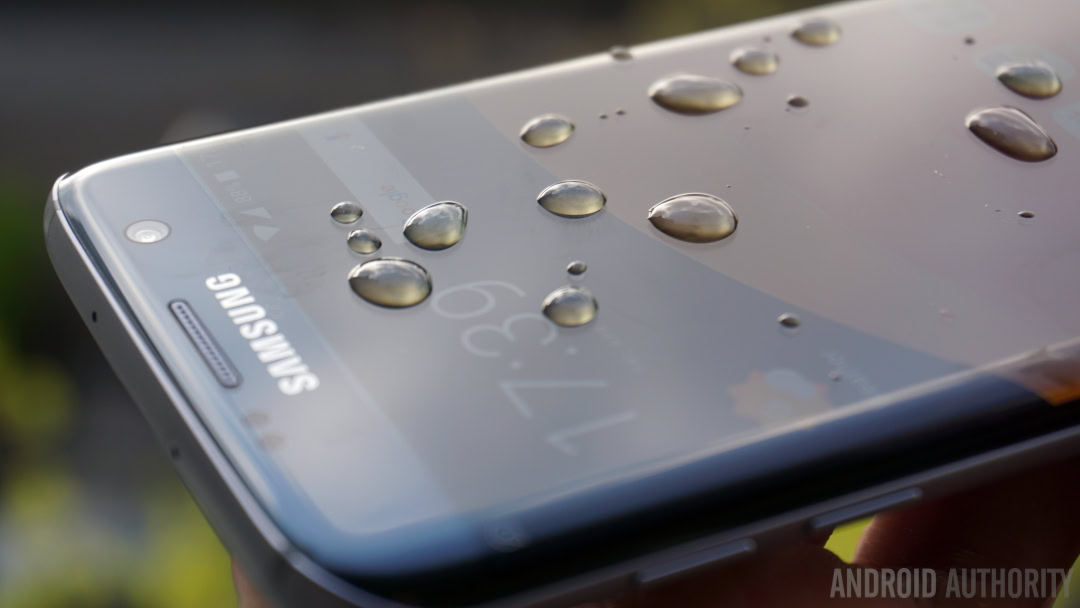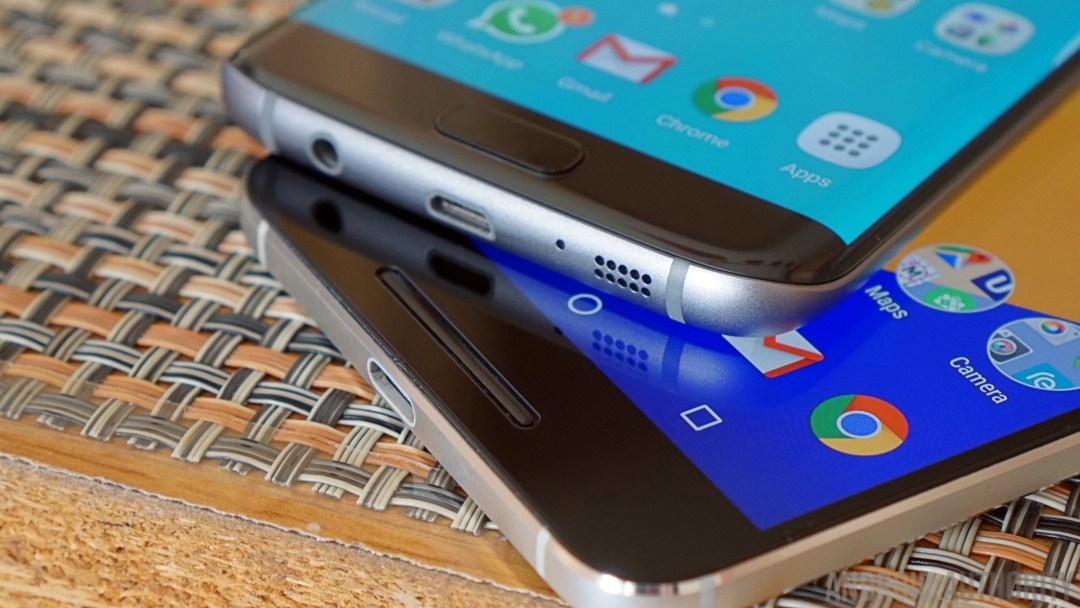Affiliate links on Android Authority may earn us a commission. Learn more.
The pros and cons of waterproof (water-resistant) phones
Published onJanuary 28, 2017

How important is smartphone water resistance? For some people, it’s no doubt a must-have feature. For others, it’s a luxury. Water resistance can act like inbuilt smartphone insurance, protecting your investment in case of an accident. But, like insurance, it can come at a considerable cost.
Is it really worth it? Let’s explore that.
Definitions
When we talk about waterproof smartphones, what we’re often referring to is water-resistant phones.
The common waterproof definition is “impervious to water.” Smartphones are not truly impervious to water, but instead are resistant to water in certain circumstances. What you might also be surprised to learn is that those circumstances can be quite specific.
The highest smartphone water resistance rating right now is IP68, which means certified devices can survive in 1.5 metres of fresh water for up to 30 minutes, although many OEMs define their own test parameters. (You can read more about IP (ingress protection) ratings and what they mean at the link.)

Like “best before” dates on your groceries, these IP ratings are more often than not just a guide. Not to the extent that you could leave your phone in a pond overnight and expect it to be fine the next morning — although those stories certainly exist — but if a phone is in water for 31 minutes, as opposed to 30, chances are it will still be okay.
Nonetheless, even with water resistance as a specific property of your smartphone, there’s no guarantee that it’s going to survive water attacks in every circumstance. And inversely, some phones that aren’t sold with an IP rating are pretty darn water-resistant, like the original Moto G.
Costs [part one]
So your phone isn’t waterproof, but with water resistance, it could survive liquid encounters that may ruin a non-water-resistant device. The next question, then, is what’s that worth, both to the manufacturer and you as a consumer?
Applying water resistance to a phone is believed to be expensive. Not simply thanks to the cost of glueing protective rubber on the inside of the device, but in developing the product with water resistance in mind. Xiaomi’s co-founder Lei Jun once said it would add 20-30 percent to the cost of its phones. The price will, of course, vary depending on the manufacturer, but they will always increase the production costs of the device.
Now, that doesn’t mean every water-resistant phone is more expensive than every non-water-resistant phone, simply that you will pay more for the privilege of the extra protection.
Before we move on, also consider that IP ratings don’t cover usage underwater. You’re not paying a premium for fun, the benefit is purely concerned with protection in case of accidents. Remember Sony rewriting its waterproof definition a while back?
To try and contextualize the benefits of an IP rating against its cost, let’s look at some numbers.

What are the chances?
It’s actually quite difficult to find concrete data on the number of phones dropped in water. It isn’t always reported to manufacturers and statistics are often provided by companies which have an interest in generating concern. With that in mind, here are some figures.
Study one
After surveying “more than 2,000 iPhone users,” in 2012, SquareTrade estimates that 27% of iPhone owners who had damaged their device had done so with liquid. (Note that even though there were less iPhones in circulation in 2012 than now, that shouldn’t affect the percentage that are damaged by liquid.)
The study also found that 30% of iPhone users had damaged their device within the 12 months preceding the survey.
So, nearly one in three iPhone users damaged their device in 2012, and nearly one in three of those were through liquid damage. Based on that, we could say about one in ten iPhones were damaged by liquid in 2012.
As with the other surveys below, we don’t know what kind of liquid was involved in those instances, and whether water resistance would have protected the devices (losing a smartphone overboard while at sea limits your chances). But let’s say for argument’s sake that an iPhone stands about a ten percent chance of becoming liquid damaged and that it’s about as easy to drop as an Android phone.
- Result: 10% chance of liquid damage
Study two
Another headline grabber, this study from 2011 by Plaxo suggests almost one in five people drop their phone in the toilet.
Toilet water is not fresh water (the degree to which this is true would, I concede, depends on when exactly in the process the device is dropped). Though water resistance would likely protect you in that scenario, it’s outside of the IP certification terms.
I would argue that these toilet drops occur to a greater extent now than in 2011 because there are more unwieldy and slippery smartphones in operation and ever more reasons to check a phone while in the bathroom. But we’ll stick with the number given.
- Result: 19% chance of liquid damage
Study three
A more recent study, this one from ZAGG in 2014, says 30% of those who participated had suffered a liquid damaged phone and 50% of all users who had damaged their phone repaired or replaced them. Incidentally, that also means about half are running around with a damaged phone.
- Result: 30% chance of liquid damage
Based on the findings above: the chance that your phone will become liquid damaged is apparently about 10-30%. Or, on average, 20%.

Costs [part 2]
The cost of water resistance
The price you pay for water resistance will depend on the phone. On a new flagship, assuming the 25% average from Xiaomi’s estimates is accurate, that means on a $400 or $800 dollar device you’d pay an estimated $100 or $200 for water resistance as a feature.
Of course, this figure is up for debate and may reflect the low-cost of Xiaomi’s handsets — that is to say that Lei Jun may have been speaking of an extra $25 on a $100 dollar phone, rather than $125 0n a $500 phone. Still, water resistance is regarded as a premium feature.
The cost of repair
Repairing a water-damaged phone is usually costly as it requires dismantling the handset. One estimate puts it at anything from £65 (~$80) to more than £200 (~$250), but note that it’s not a given in every case that the phone is even repairable.
Outcome
These numbers indicate that there’s a 20% chance that your phone will become liquid damaged, and you could probably pay between $100-$200 for the feature that provides a chance at preventing it. And it’s that chance of prevention that is crucial, here: there is no guarantee that the device would be protected in anything other than 1.5 metres of fresh water. It’s probable that it would survive having coke spilled on it, but not certain.
A 20% more expensive phone, or $80-$250 to potentially have it repaired. Maybe more, maybe less. Maybe not repairable at all.
Other considerations
Adding water resistance may not just affect the costs of a device either, but what it’s like to use. Insulating a phone may affect its size, thickness, weight, and perhaps the audio quality of its speakers. Then there are third-party waterproofing technologies you can add to a device or waterproof cases. Their benefits (or lack thereof) deserve to be studied but I don’t want to bring too many variables to the table in this article.

Wrap-Up
What I’ve outlined here is based on estimates using a variety of sources. There’s no definitive answer to how much water resistance costs you, how much it could save you or how likely it is to come into play.
Further, the data above may not necessarily be accurate. ZAGG sells mobile accessories, SquareTrade is a phone insurer, and Plaxo provides backup and sync solutions: these companies would stand to benefit should conclusions suggest smartphone damage is common. That’s not to mention that Xiaomi’s 20-30% increased costs seems pretty high (the water-resistant iPhone 7 wasn’t 20% more expensive than the iPhone 6). Yet, water-resistant phones still tend to be more expensive than non-water-resistant competitors.
Where does that leave us?
Anecdotal evidence might better corroborate the frequency of the situation than those studies: you likely have, or know somebody who has, damaged their phone with liquid. It seems common and in such cases, you may have to throw away the device or repair it, which can be expensive. Water-resistance may help prevent that. It totally depends on where/how you drop it and into what.
Should you always buy a water-resistant phone? While I don’t think it’s a bad idea, I wouldn’t say it’s essential: the odds are still in your favor when it comes to whether your phone will become water-damaged. Thankfully, greater numbers of water-resistant phones are being released all the time and that number is likely to continue to grow, so “paying more” won’t necessarily even be a consideration.
What I think is a more relevant question, however, is whether you should buy a case.
Most studies on damaged phones indicate that they are more often harmed by a fall than by water damage. With that in mind, you might need to ask yourself if you want to prioritize water resistance over a 10 dollar protective cover.
Survival depends on the type of case, just as it depends on the type of water. But, really, if your aim is to protect your device and save money, a case is a form of insurance that you’re more likely to benefit from than water resistance. And they don’t cost much.